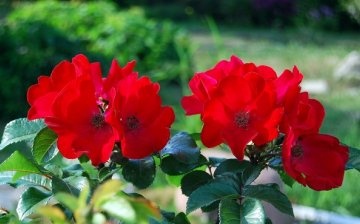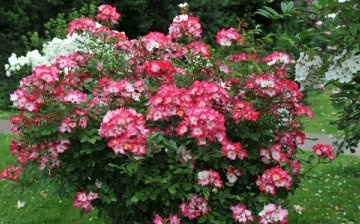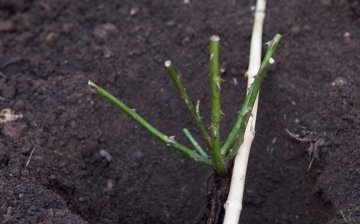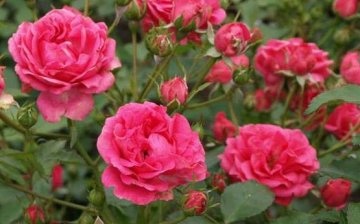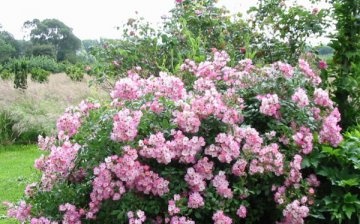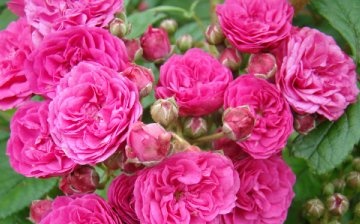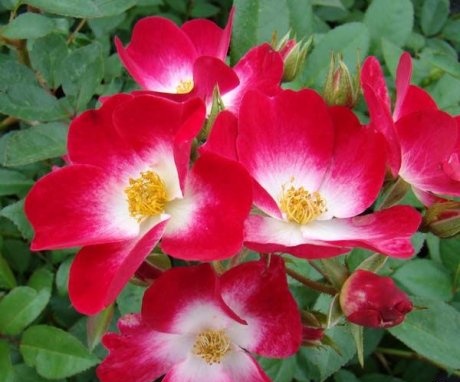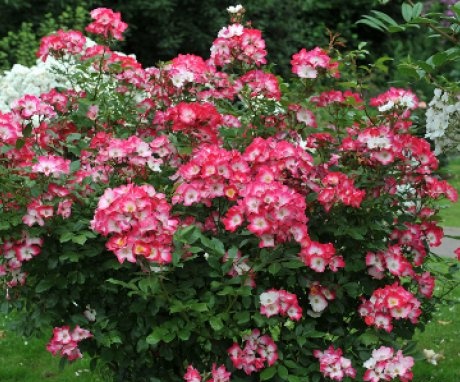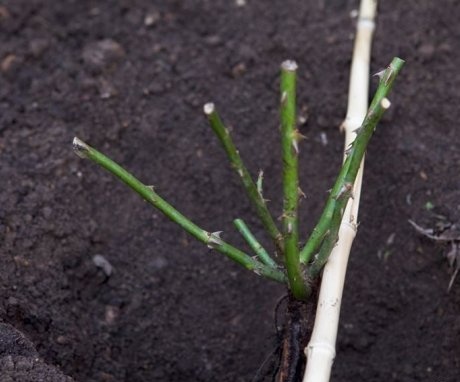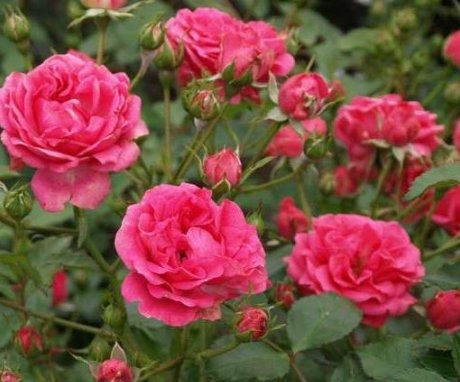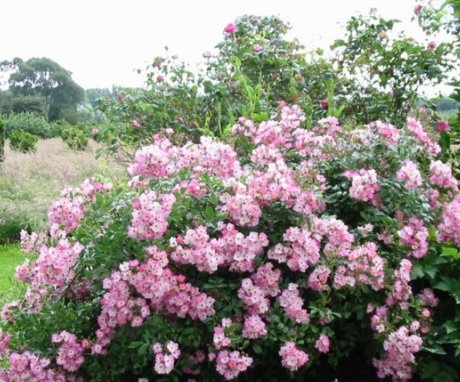Musk roses - growing: from planting to grooming
Growing roses and caring for them is quite troublesome. Musk (landscape) roses differ from others by their low maintenance requirements. Their advantages are beauty, pleasant aroma of flowers.
Content:
- The origin of musk roses
- Description of musk roses
- Reproduction and planting
- Care Tips
- Musk rose application
The origin of musk roses
The "Maschada" variety is considered the progenitor of modern musk hybrids. Most likely it is a hybrid of the Persian rose "No Strana", which is used in the homeland as a medicinal plant. "Maschada" is a shrub with long hanging shoots, decorated with clusters (7 pieces each) of white fragrant flowers. It appeared in Europe at the beginning of the 16th century. Many noisette (fragrant, with large inflorescences) and climbing roses have been bred on the basis of the Maschada rose.
The founder of a whole group of hybrids, called musky, was the German breeder Peter Lambert.
The second name of these roses is landscape. It indicates the main purpose of plants - to decorate territories. At the end of the 19th century, Lambert was engaged in the cultivation of new varieties in his nursery in Trier. Having received multiflora roses of varieties "Tale" and "Aglaya", he wanted to create a new variety. The rose had to bloom not only beautifully and profusely, but also all summer, that is, it would have repeated blooming.
At the beginning of the 20th century, the first musky hybrid "Trier" was released. It was abundantly covered with white bouquets several times per season. Inspired by this result, Lambert continued his work and created 27 more remontant varieties of multiflora, which he called "Lambertianos". The most beautiful variety is considered "Mozart". Created in 1936, it gained wide popularity and has not lost it to this day.
An English married couple, the Pembertons, Joseph and Lawrence, became interested in the work of the scientist. It was they who created such now famous varieties as "Felicia", "Mon Light", "Cornelia". In total, they created almost the same number of roses as Lambert, 27. They began to call them musky hybrids. Spouses John and Anne Bentol created the "Ballerina" rose. American John Thomas first bred a yellow musk rose. Jack Harkness made a great contribution to the creation of landscape roses. He created many interesting varieties, including "Red East", "Red Ballerina", "Alice Princess of the Phoenix" with a burgundy center.
Now new varieties of these roses are being created in the nursery of the Belgian Louis Lens. The most famous among them:
- "Dinky" with bright pink petals.
- "Havenly Pink" with light pink flowers.
- "Waterloo" with white flowers and a yellow center.
- "Bukavu", the petals of which are bright pink at the edges, and white towards the center.
In fact, most musk hybrids are distant cousins of the musk rose through an intermediate (poazeta roses). And they got their name for a similar aroma.
Description of musk roses
Musk roses include the following types of roses:
- Multiflora
- Venice
- Mooligans
- Sempervirens
- Avensis
Landscapes have different colors, but you can still highlight the main features that distinguish them from the rest. Almost all Muscat roses are tall, up to 2 m in height. They are often grown on a support. If this is not done, the lashes will droop down, and the bush will become wider.The flowers themselves are small, often not even double. But during the period when the bush is blooming, it is not striking. Due to the large number of bouquets, it is very decorative.
Most of them have an unusual aroma for roses, which led to the name "musky".
It is similar to the smell of flower honey. Spices are mixed there, including carnation, nut... In this case, the smell comes from the stamens. In order for the whole garden to be filled with a delicate aroma, one bush of musk roses of the following varieties is enough:
- "Cornelia" with flowers of different shades of white and pink.
- "Daphnia" with cream flowers.
- "Buff Beauty" in apricot color.
- "Felicia", the petals of which are pink on the inside, apricot on the outside.
- "Pax" with white flowers and a yellow center.
- "Vaniti" with bright pink flowers.
Unfortunately, the most beautiful hybrids have almost no smell. Musk roses do not bloom like ordinary roses. The buds first appear at the ends of the basal shoots that extend from the base. When most of the flowers have almost faded, a large number of side shoots appear. Flower buds are also formed on them. Therefore, the second bloom is much more abundant than the first. After all, the side bouquets are ten times more than the top ones.
The buds also open differently from the usual ones. roses... In musky ones, they bloom all together. Therefore, the bush looks very impressive during flowering. There are practically no leaves behind the flowers.
Reproduction and planting
Musk rose propagates cuttings and layering. Can be grafted to rose hipsbut gardeners do not find it advisable. Cuttings take root easily and tolerate winter frosts well. An adult plant is bent to the ground for the winter. Multiply seeds not worth it as they do not preserve the properties of the parent.
Musk roses are undemanding to growing conditions.
Planting plants with an open root system possible in spring and autumn, with closed - all summer. A rose planted in autumn will take root by spring and will bloom on a par with the plants planted earlier. But this method justifies itself only if it was possible to guess the weather. If the winter is early and frosty, the bush may not have time to take root and will freeze. But if there is no frost for a long time, then the buds may begin to bloom, and the sprouts will die in winter. Therefore, it is safer to plant musk roses in the spring.
The planting site can be sunny with light shade during lunch hours. But even in partial shade, they grow very well. But drainage is necessary for roses, otherwise the root system can rot. They grow well in elevated places where moisture does not accumulate even in spring after snow melts and after heavy rains.
Landing rules:
- Prepare a pit measuring at least 60 cm in depth, length and width. While musk roses can grow in almost any soil, they will be much more luxuriant in rich soil.
- Add organic fertilizers and missing components (sand to improve drainage properties, clay to retain water in the soil). For about 1 bush, you need 2 buckets of peat, a bucket of sand, 2-3 buckets of leafy soil. If at the time of planting it is not possible to prepare the soil, you can plant the musk rose in ordinary soil and feed it later.
- Often a new rose is planted in place of the old one. In this case, the soil must be completely replaced in order to rid the plants of the influence of pathogens left over from the dead plant.
- It is better if the pit is prepared in advance, in the fall, or at least a few weeks before planting. This will allow the soil to settle. If dug just before planting, which happens often, you need to more carefully compact the soil. If this is not done, then the seedling may fall into the ground along with the settled soil.
- At the bottom of the pit, a mound is formed on which it is convenient to place the roots. They should be located radially from the trunk.
- Own-rooted varieties are planted so that the heel is at a depth of several centimeters from the soil surface.
- If it turns out that the seedling has sunk into the soil too deep, you can pull it up. But this must be done very carefully so as not to cut off the roots.
Planting can be dry or wet. When dry, the plant is immersed in a hole, covered with prepared soil and then watered. In wet planting, water is poured immediately after the seedling is set on the bottom of the pit. A liquid mixture is formed, which moisturizes the plant roots well. They wait until the water is absorbed a little, and they cover it with soil.
Care Tips
After planting, watered and spud bush. Constantly make sure that the soil near the musk rose is moist. This is especially important in the first year of life, when the plant is just taking root. Helps retain moisture mulching humus or grass cuttings. Mulch will protect the plant from drying out. Musk roses hardly get sick and are not affected pests... When signs of powdery mildew appear, they are treated fungicides.
If the leaves infect caterpillars, and tender buds - aphidusing insecticides.
Musk roses are pruned very carefully. If necessary, remove up to a third of the length of the branches. But it is better not to carry out any circumcision other than sanitary. Only broken, weak and diseased branches are removed. In young bushes, after planting, you need to cut off the buds. This will help the rose take root faster.
After flowering, fruits can be set on the rose. They are the same as those of the wild rose hips. You can leave them on the bush. This will beautify it for a few more months. If you need to get as many flowers as possible, the fruits are cut off.
Musk rose application
Musk roses are most often planted in the background of a garden or flower garden... Their flowers are not as beautiful as those of hybrid tea varieties. But from a distance they look good and serve as a great backdrop for other colors. Combine with ornamental cereal plants.
Looks good with other species roses, including hybrid tea. You can make a monochromatic or contrasting composition.
There are low varieties of musk roses that can be planted in the foreground - this is the "Ballerina" in the shape of a ball.
High varieties look great next to contrasting colors. clematis... They can be placed near the benches where the owners often rest, next to the conversation. Growing musk roses is advised for novice gardeners. They take root more easily, and caring for them is simple.
More information can be found in the video:



